Monoamine
Hazard to Others
  
Posts: 168
Registered: 25-5-2021
Location: Sweden(ish)
Member Is Offline
Mood: +7
|
|
Sulfur trioxide (SO3) misshap (and fix)
It was a cold and stormy day so I decided to go outside and make some oleum...
Scroll down for images.
First of all, oleum is a solution of SO3 in sulfuric acid H2SO4. SO3 is a versatile and useful reagent
with many applications such as sticking sulfur groups on organic compounds and making thionyl chloride, among others. It is the anhydride of sulfuric
acid and is therefore very corrosive and oxidizing and almost immediately blackens any organic material it comes in contact with. It also reacts
extremely exothermically with water, which is why glassware containing it can often shatter when water is splashed into it.
I wanted to try out a method by user "Garage Chemist", which makes SO3 by heating sodium persulfate
(Na2S2O8) in the presence of some catalytic concentrated H2SO4 to about 300oC and
distilling off the SO3. The paper with the procedure can be found here: Garage Chemist: Preparation of sulfur trioxide.. This method is great because is uses the readily available precursor
Na2S2O8, which is widely used for etching copper and circuits.
I followed this procedure, but changed only the amount of reagents as well as adding on two features: Filling the receiving flask of the distillation
with some 95% H2SO4 and also adding a hose leading to an upturned funnel in a 95% H2SO4 bath, to the gas
takeoff adapter. The first modification served to give the SO3 something to dissolve into, and the second served as a barrier to prevent
moisture from getting in and to prevent fumes from getting out.
Let me outline what I did wrong and how some of the mistakes were partially fixed:
Mistake 1: Doing all of this on a rainy day. Probably not ideal conditions, but it wasn't a problem in the end.
Mistake 2: I added the catalytic H2SO4 to a preheated flask which, apparently was already heated to well over the boiling
point of H2SO4, since the sulfuric acid started to boil as soon as it was added to the flask and I inadvertently cooked off some
of the sulfuric acid before I could add all the sodium persulfate to the flask. This was fixed by just adding in a bit more sulfuric acid.
Observation 1: Even though SO3 boils at only 44.9oC, it cooled off too fast to come over before it reached the (uncooled)
condenser, even though the heating mantle was cranked to full.
Mistake 3: To fix this, the boiling flask and the still head were wrapped in aluminum foil. This worked far too well! I had actually forgotten
to take off the plastic Keck clips, which promptly melted. To make matters worse, the plastic fritt that secured the thermometer reaching down into
the flask also melted and dripped into the boiling SO3!!! A small explosion ensued. Fortunately, the only thing that
shattered was the thermometer. However, some of the molten and oxidized plastic fritt did get blown into the condenser column and contaminated the
oleum in the receiving bottle making it brownish.
Fix: Since most of the glassware was yet intakt, the defective still head was replaced by one made entirely of glass, and the distillation was
continued until the drip rate slowed to about once every 5 seconds or so.
Observation 2: The volume in the receiving flask decreased by about 20ml during the downtime from the disaster. This would suggest that
unstoppered, SO3 is rapidly lost out of oleum from fumes.
Observation 3: When covered by aluminum foil, the inside of the heating mantle starts to glow orange hot! (See image).
Well there you have it. Some things worked, some didn't, lessons learned for next time. I hope you can find some use for my blunders and not make the
same mistakes I did.
[Edited on 28-11-2021 by Monoamine]
|
|
|
Monoamine
Hazard to Others
  
Posts: 168
Registered: 25-5-2021
Location: Sweden(ish)
Member Is Offline
Mood: +7
|
|
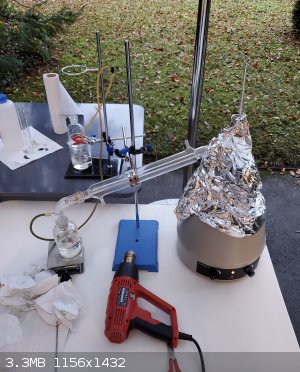
[Edited on 28-11-2021 by Monoamine]
|
|
|
Monoamine
Hazard to Others
  
Posts: 168
Registered: 25-5-2021
Location: Sweden(ish)
Member Is Offline
Mood: +7
|
|
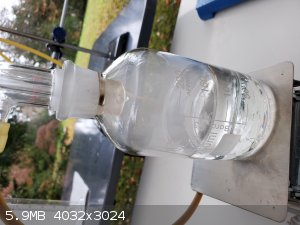
|
|
|
Monoamine
Hazard to Others
  
Posts: 168
Registered: 25-5-2021
Location: Sweden(ish)
Member Is Offline
Mood: +7
|
|
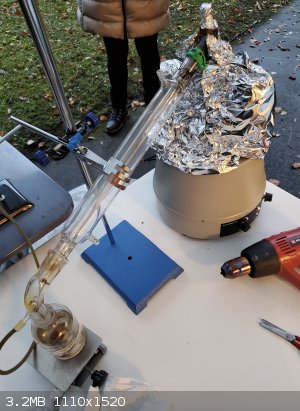
|
|
|
Monoamine
Hazard to Others
  
Posts: 168
Registered: 25-5-2021
Location: Sweden(ish)
Member Is Offline
Mood: +7
|
|
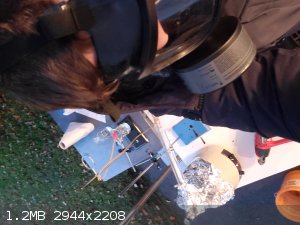
|
|
|
Monoamine
Hazard to Others
  
Posts: 168
Registered: 25-5-2021
Location: Sweden(ish)
Member Is Offline
Mood: +7
|
|
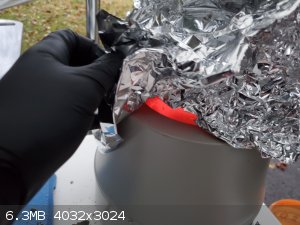
|
|
|
Admagistr
Hazard to Others
  
Posts: 383
Registered: 4-11-2021
Location: Central Europe
Member Is Offline
Mood: The dreaming alchemist
|
|
Even when things didn't go the way they were supposed to, you did a good job, nicely documented, photographed, described ! That's what it should look like, setting a good example for others. ! That's what it should look like, setting a good example for others.
I prefer not to use laboratory plastic in the apparatuses if there is any other way, I use metal. Although metal has its drawbacks, it's corroded by
acids, and if you tighten the glass a lot it can crack...
|
|
|
Monoamine
Hazard to Others
  
Posts: 168
Registered: 25-5-2021
Location: Sweden(ish)
Member Is Offline
Mood: +7
|
|
Thanks for the tip about glass cracking when it's tightened too much. Haven't had it happen yet, but now I can watch out for it.
|
|
|
AJKOER
Radically Dubious
    
Posts: 3026
Registered: 7-5-2011
Member Is Offline
Mood: No Mood
|
|
My recent thoughts based on a source providing a guide on reaction rates relating to SO3 formation. Please review Page 209, here https://www.google.com/books/edition/Sulfur_in_the_Atmospher... by clicking on the 'Preview' key.
Based on this reference, I no longer, for example, recommend a Singlet oxygen path, but a path based on nitrogen oxide radicals that appears strong.
As to revised ideas, I once noted a seemingly strange path to SO3 cited in an old text that passing SO2 over HNO2 that can reputedly create SO3 (see
citation here http://www.sciencemadness.org/talk/viewthread.php?tid=85001#...). However, more recently, I found a reference consistent with such a path. Some
ideas as to how to implement follow, starting first with the proposed action of UV light on HNO2:
HNO2 + UV -> •OH + •NO
Or, perhaps better, •NO as a generated product from the decomposition on heating of HNO2, per Wikipedia https://en.wikipedia.org/wiki/Nitrous_acid , to quote:
"Gaseous nitrous acid, which is rarely encountered, decomposes into nitrogen dioxide, nitric oxide, and water:
2 HNO2 → •NO2 + •NO + H2O"
where HNO2 can be created, for example, by the careful step wise addition of H2O2 to NH3 (see https://www.researchgate.net/publication/317692348_Effects_o...) with an approximate reaction (use as a working estimate) given by:
NH3 + 3 H2O2 -> HNO2 + 4 H2O
where even dilute HNO2 here may be acceptable as it can be dehydrated (with CaCl2) or warmed to induce primarily nitrogen oxide product formation.
Note: a better (less water) perhaps choice on thermal decomposition at 330 C is Mg(NO3)2 with products, per Wikipedia https://en.wikipedia.org/wiki/Magnesium_nitrate:
2 Mg(NO3)2 → 2 MgO + 4 NO2 + O2
where MgO is a photocatalyst and note the added benefit of oxygen.
Continuing with the presumed action of minor water vapor on SO2:
SO2 + H2O = H2SO3 = H+ + HSO3-
My suggested path to the apparent required radical •HSO3 (per the source link provided below) is:
HSO3- + •NO -> •HSO3 + NO-
the last ion being a precursor to unstable H2N2O2. Note, the reaction rate between HSO3- and •NO2 (from the oxidation •NO) is provided previously
on Page 209, Eq 27 in the opening reference.
And finally, per Equation 10 at https://www.ncbi.nlm.nih.gov/pmc/articles/PMC7558052/ , the final reaction with air/oxygen is claimed to be:
•HSO3 + O2 -> SO3 + H+ + •O2-
A confirming source on this path, per Page 43 at https://mymission.lamission.edu/userdata%5Cpaziras%5CChem102... , •NO being apparently a known catalyst for the action of O2 and SO2 leading to
SO3.
However, not sure if one can obtain a good amount of SO3 here, but the chemistry is suggestive of any path that conveniently radicalize humid SO2
creating •HSO3 which is further exposed to oxygen. For example, humid SO2 in strong light and air which actually is mentioned in Atomistry on SO3 at
http://sulphur.atomistry.com/sulphur_trioxide.html , to quote:
"Sulphur dioxide, when exposed to strong illumination, undergoes partial and reversible conversion into sulphur and sulphur trioxide."
which also suggests adding a strong photocatalyst (like ZnO, as conveniently sourced from zinc acetate at https://nanoscalereslett.springeropen.com/articles/10.1186/s...) where the electron hole (h+) may promote the •HSO3 radical formation:
HSO3- + h+ -> •HSO3
Another, less friendly path, but well known:
"Sulphur trioxide is formed to a small extent together with sulphur dioxide when sulphur or compounds of sulphur are burned in oxygen or air. In an
oxygen tomb, in the presence of a compound which on combustion yields water vapour and oxides of nitrogen, for example ammonium nitrate, the
combustion goes completely to sulphur trioxide."
Albeit, note: "Ammonium nitrate mixed with sulfur or with metal powders can be exploded by shock. " per https://webwiser.nlm.nih.gov/substance?substanceId=453&i... .
===========================
An interestingly idea on a more speculated path (which I surmised from the opening reference) is to employ the •HO2 radical, albeit, only half as
effective as •NO2, but this idea may still provide a workable and safer path.
In the current context, •HO2 could perhaps be conveniently formed from say a solid peroxide like zinc peroxide mixed with riboflavin subject to
water vapor and strong fluorescent light (see Reactions (6) to (9) here https://www.tandfonline.com/doi/pdf/10.1080/10473289.1996.10... and also this source: https://www.researchgate.net/publication/6323324_Formation_o... ).
Expected reactions leading to •HO2 are:
ZnO2 + H2O (vapor) = ZnO + H2O2
H2O2 + UV = •OH + •OH
H2O2 + •OH -> H2O + •HO2
and thereby theoretically also some SO3 in the gas stream per cited Reaction (31), which per the cited text may also be photochemical based again with
riboflavin as the photocatalyst under strong fluorescent light:
•HO2 + SO2 -> •HO + SO3 (31)
which all occurs apparently at around a reaction rate of 1/2 of the cited reaction rate with •NO2, namely:
•NO2 + SO2 -> •NO + SO3 (27)
where the SO3 would hopefully appear as a fine white deposit with cooling.
Kind of an interesting idea as one would be working without exposure to a very toxic acidic gas or high temperatures used to induce radicalization,
albeit all likely slower with a reduced yield.
Note: This approach can be viewed as cited above "Sulphur dioxide, when exposed to strong illumination, undergoes partial and reversible conversion
into sulphur and sulphur trioxide" with the added benefit of a peroxide (ZnO2) and also the photocatalyst ZnO created from the ZnO2, all in a very
amenable path.
[Edited on 27-12-2021 by AJKOER]
|
|
|
Metacelsus
International Hazard
    
Posts: 2544
Registered: 26-12-2012
Location: Boston, MA
Member Is Offline
Mood: Double, double, toil and trouble
|
|
Oh no, AJKOER's rambling on about UV and nitrogen oxides again.
|
|
|
|